Park County COGenWeb
COGenWeb a proud partner of USGenWeb
Women and Ranching
Women On a Hay Rake
These ranch women are posed with a horse and a hay rake. Both women are wearing bib overalls and long sleeve shirts. The strings around their necks suggest they are wearing hats to shade them from the sun. [The hats are hanging behind their backs.]
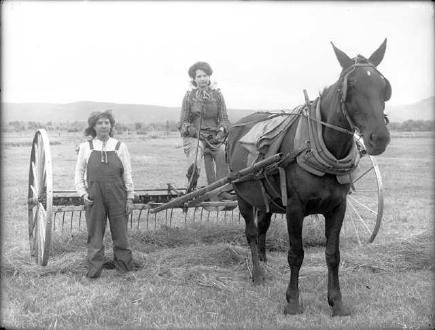
Photo: Denver Public Library, Western History Collection
More About This Topic
Working hay--whether cutting it, raking it, or stacking it--was hard, hot, and dusty work. Work clothes like these protected ranch women (and men) from both the sun and hay dust. This photo was taken about 1890.
Their Own Words
“Seems like we always had to work together—boys and girls. I was the oldest—of course, I always had to take the boy’s part. . . . We always had to be out and take a man’s place. . . . Oh, yes. That was our job, to mow hay. . . . Well, you had an old mower—a horse mower, with two horses on it. You pitched it onto a wagon with a fork. Mother and I and all of us would all get out and pitch hay, load it onto a wagon, and haul it to the stack, and you stacked it.”
Source: Hilda Shelton Rawlinson quoted in Julie Jones-Eddy, ed. Homesteading Women: An Oral History of Colorado, 1890-1950, (New York: Twayne, 1992): 88.
Branding a Steer (1884)
This photo shows ranch women branding a steer. The photo was taken in 1884 on a cattle ranch in the San Luis Valley.
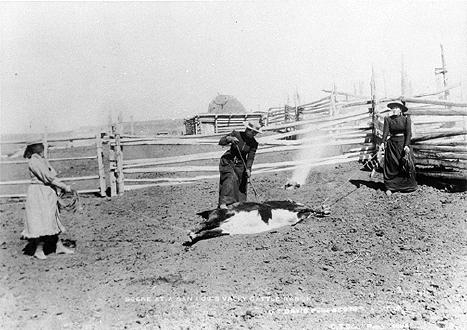
Photo: Colorado Historical Society
More About This Topic
Women, as well as men, lived and worked on cattle ranches. However, very few women worked as cowboys during a roundup. Examine this photo closely. Are these women dressed for roping and branding cattle? Do you think they roped and tied the steer in the photo?
Their Own Words
“Never did wear pants, and I haven’t yet! I leave that to the men. I did—I wouldn’t wear them. You know, my legs feel like they’re smothered. I’d be out there at our ranch, and in the wintertime [my husband] was always gone up to Mt. Harris to work, because we needed the money. I stayed home, took care of the cattle, horses, and everything. Pumped water for them and all. Well, after we had a few head of cattle, I had to hook up our team of horses and haul the straw out—we didn’t have hay; it was straw—and pump the water and slop the pigs and take the kids to school when they started. . . . “
Source: Julia Biskup Kawcak quoted in Julie Jones-Eddy, ed. Homesteading Women: An Oral History of Colorado, 1890-1950 (New York: Twayne, 1992): 64.
Raking Hay
The woman in this photo is sitting on the seat of a hay rake in a hay field.
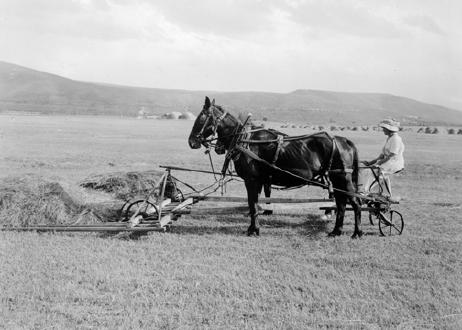
Photo: Denver Public Library, Western History Collection
More About This Topic
Putting up hay usually was a man’s job. The woman in this photo must have been helping out in the field during the busy haying time.
Their Own Words
“Well, there were chores the boys did and chores that the girls did too, but it always seemed to me like I wasn’t considered a boy and I wasn’t considered a girl! I worked in the hay field, and I would go out and buck-rake hay or rake hay all day long. Then at night when we came in, why, the boys got to sit down but I had to help with the dishes; I had to help the girls do these too.”
Source: Audrey Ruckman Oldland quoted in Julie Jones-Eddy, ed. Homesteading Women: An Oral History of Colorado, 1890-1950. (New York: Twayne, 1992): 87.
Two Colorado Ranch Women
This photo shows two women standing beside horses on a ranch in Colorado. They may have been out for a Sunday ride. Both the women and the men are dressed in good clothes.
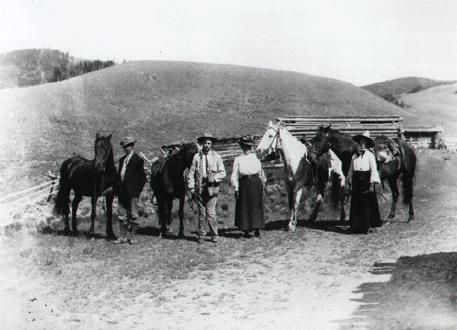
Photo: Colorado Historical Society
More About This Topic
On the ranches of Colorado, women as well as men rode horseback. Some rode on special saddles made for riding while wearing a skirt. These were called sidesaddles. The saddles on the women’s horses in this photo are ordinary western saddles.
Their Own Words
“Of course, cowboys used to stop in to Mrs. Miner’s [the place June was staying during her first teaching job] for lunch or something, and I thought, ‘Well, they stopped in to see the new school-teacher!’ One cowboy that stopped in was Henry Sweeney, who, the following June, I married. I had saved my money . . . to go back to college. My husband . . . let me go back to Greeley for the spring quarter . . . and he came after me the first of June. Then I taught that next year at Lay. I rode horseback seven miles to Lay, on a beautiful big palomino stallion that Henry brought to the door every morning and put me on.”
“And Mr. Menninger over at Lay . . . was always there to help me off and to take my horse and put him in the barn. He never failed to have that horse ready for me to go home at night, and help me on.”
Source: June O’Connell Sweeney quoted in Julie Jones-Eddy, ed. Homesteading Women: An Oral History of Colorado, 1890-1950 (New York: Twayne, 1992): 188.
Ranch Women Among Cowboys
This photo shows two women and several men on a Colorado ranch. The building on the right is the ranch bunkhouse.
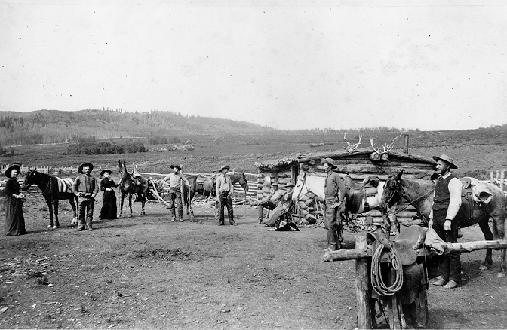
Photo: Colorado Historical Society
More About This Topic
The women in this photo probably were the wives of ranchers. The men who worked on the ranch slept in the bunkhouse at the right.
Their Own Words
“June [Oma’s husband] was a good hand with a team [of horses], and [Mr. Dunn] said, ‘I’ll give you $5 a day to come up and skid logs and Oma can run the cattle. Oh, man—we thought we were on top of the world! I took care of the cattle, and June skidded logs. Well, we both liked to dance; we both liked to ride horseback; we liked the same things. We run the cattle then. And then that fall we brought them back, because you have to feed in that upper country [in winter]. We had $80 to go into the winter with. We lived in a cabin about the size of that carpeted place [gestures]: 12 by 14 [feet], let’s say.”
Source: Oma Jensen Graham quoted in Julie Jones-Eddy, ed. Homesteading Women: An Oral History of Colorado, 1890-1950, (New York: Twayne, 1992): 68-69.
Sawing Fire Wood
This young farm woman is sawing a log. There are several things you should notice in this photo. Notice that there are very few trees to be seen. These ranchers probably had to haul logs a long way, which meant hard work. Notice also the size of the saw. Working a saw this large was extremely hard work.
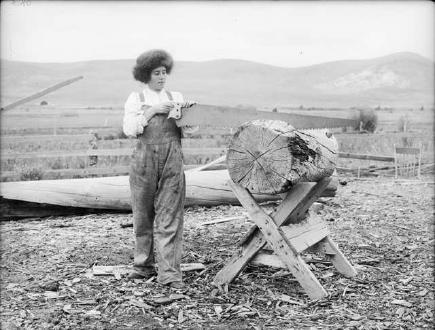
Photo: Denver Public Library, Western History Collection
More About This Topic
Another thing you might note is that the log is resting in a saw horse that is probably too high for this young woman to saw easily. Finally, the young woman is wearing bib overalls, which probably means that she did many kinds of chores around the ranch. This photo was taken about 1890.
Their Own Words
“In the summertime I’d help hay. And, of course, we had our chores. We had to help carry in the water, get the wood, feed the chickens and gather the eggs, and sometimes milk the cows. . . . Well, when [my Dad] cut [fence] posts he’d make me snake them with a horse. . . . You take a log chain and hook them around two or three or four posts, usually from a saddle horn. And then you’d get on the horse and snake them to where you could get to the wagon to load them on the wagon.”
Source: Ethel La Kamp Chrisler quoted in Julie Jones-Eddy, ed. Homesteading Women: An Oral History of Colorado, 1890-1950, (New York: Twayne, 1992): 83-84.
Women On a Hay Rake
These ranch women are posed with a horse and a hay rake. Both women are wearing bib overalls and long sleeve shirts. The strings around their necks suggest they are wearing hats to shade them from the sun. [The hats are hanging behind their backs.]

Photo: Denver Public Library, Western History Collection
More About This Topic
Working hay--whether cutting it, raking it, or stacking it--was hard, hot, and dusty work. Work clothes like these protected ranch women (and men) from both the sun and hay dust. This photo was taken about 1890.
Their Own Words
“Seems like we always had to work together—boys and girls. I was the oldest—of course, I always had to take the boy’s part. . . . We always had to be out and take a man’s place. . . . Oh, yes. That was our job, to mow hay. . . . Well, you had an old mower—a horse mower, with two horses on it. You pitched it onto a wagon with a fork. Mother and I and all of us would all get out and pitch hay, load it onto a wagon, and haul it to the stack, and you stacked it.”
Source: Hilda Shelton Rawlinson quoted in Julie Jones-Eddy, ed. Homesteading Women: An Oral History of Colorado, 1890-1950, (New York: Twayne, 1992): 88.
Branding a Steer (1884)
This photo shows ranch women branding a steer. The photo was taken in 1884 on a cattle ranch in the San Luis Valley.

Photo: Colorado Historical Society
More About This Topic
Women, as well as men, lived and worked on cattle ranches. However, very few women worked as cowboys during a roundup. Examine this photo closely. Are these women dressed for roping and branding cattle? Do you think they roped and tied the steer in the photo?
Their Own Words
“Never did wear pants, and I haven’t yet! I leave that to the men. I did—I wouldn’t wear them. You know, my legs feel like they’re smothered. I’d be out there at our ranch, and in the wintertime [my husband] was always gone up to Mt. Harris to work, because we needed the money. I stayed home, took care of the cattle, horses, and everything. Pumped water for them and all. Well, after we had a few head of cattle, I had to hook up our team of horses and haul the straw out—we didn’t have hay; it was straw—and pump the water and slop the pigs and take the kids to school when they started. . . . “
Source: Julia Biskup Kawcak quoted in Julie Jones-Eddy, ed. Homesteading Women: An Oral History of Colorado, 1890-1950 (New York: Twayne, 1992): 64.
This page was last